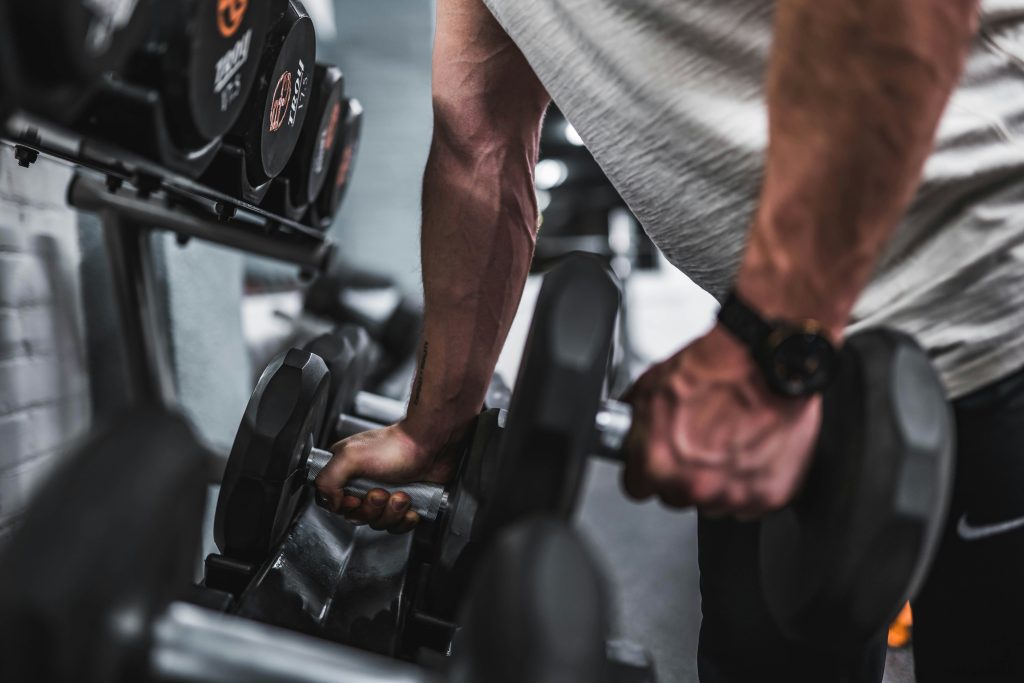If you’ve been working hard to build six-pack abs and strengthen your core muscles, you may be wondering how to keep track of your abdominal muscle development over time. It’s a common question among fitness enthusiasts, and luckily, there are a few effective ways to monitor your progress. By measuring body fat percentage, taking progress photos, and tracking your workouts and diet, you can get a clear picture of how your abdominal muscles are developing and make necessary adjustments to your fitness routine. In this article, we’ll explore these methods in more detail, providing you with practical tips to help you stay on top of your abdominal muscle development journey.
Creating a Baseline Measurement
Measuring Body Fat Percentage
When it comes to tracking your abdominal muscle development over time, one important aspect to consider is your body fat percentage. This measurement can give you a clear indication of how much fat you have stored in your body, which can affect the visibility of your abdominal muscles. To measure your body fat percentage, you can use various methods such as skinfold calipers, bioelectrical impedance scales, or DEXA scans. It is recommended to take these measurements regularly, preferably every few weeks, to track your progress.
Measuring Waist Circumference
Another effective way to monitor your abdominal muscle development is by measuring your waist circumference. This simple measurement can provide insights into changes in your abdominal fat and muscle mass. To measure your waist circumference, wrap a tape measure around the narrowest part of your waist, usually just above your belly button. Take note of the measurement and record it for future comparison. By tracking changes in your waist circumference regularly, you can keep track of your progress and make adjustments to your fitness and dietary routines accordingly.
Taking Before Photos
In addition to body measurements, taking before photos can be an excellent way to document your abdominal muscle development over time. Find a well-lit area and take front, side, and back photos of your midsection. Make sure to stand straight and relaxed for accurate comparison later on. As you continue with your fitness journey, you can take progress photos at regular intervals, such as every four to eight weeks. Comparing these before and after photos can be incredibly motivating and provide a visual representation of your hard work and progress.
Tracking Progress with Body Measurements
Measuring Body Fat Percentage Regularly
To track your abdominal muscle development effectively, it is essential to regularly measure your body fat percentage. As you engage in regular exercise and maintain a healthy diet, your body fat percentage should decrease over time. By taking these measurements at regular intervals, you can identify trends and changes in your body composition. Keep in mind that body fat percentage may fluctuate slightly due to factors like water retention, so it is important to focus on long-term trends rather than individual measurements.
Tracking Changes in Waist Circumference
Alongside body fat percentage measurements, tracking changes in your waist circumference can provide valuable insights into your abdominal muscle development. By consistently measuring your waist, you can observe if it is decreasing or staying the same over time. A decrease in waist circumference indicates a reduction in abdominal fat, which can lead to better visibility of your abdominal muscles. Remember to measure your waist consistently, using the same technique and location each time, to ensure accurate and comparable results.
Comparing Before and After Photos
While body measurements can provide quantitative data, comparing before and after photos offers a visual representation of your abdominal muscle development. By looking at the changes in your physique over time, you can gain a better understanding of the progress you’ve made. Comparing these photos side by side can be both motivational and inspiring, encouraging you to stay dedicated to your fitness journey. Remember to take photos in the same lighting and pose to ensure accurate comparisons.

Using Physical Performance Indicators
Monitoring Strength and Endurance
Physical performance indicators such as strength and endurance can be excellent markers of your abdominal muscle development. As you engage in targeted abdominal exercises, you should notice improvements in your overall core strength and endurance. Pay attention to how your body feels during exercises like planks, sit-ups, and Russian twists. Are you able to hold the positions longer or complete more repetitions? By monitoring your strength and endurance, you can gauge the progress of your abdominal muscles.
Recording Repetitions and Sets
When tracking your abdominal muscle development, it can be helpful to keep a record of the number of repetitions and sets you perform during each exercise. By noting this information, you can track your progress over time. As your abdominal muscles become stronger, you may be able to increase the number of repetitions or sets you complete. This record can serve as a way to challenge yourself and ensure that you are continually pushing your limits to promote muscle growth and development.
Tracking Weight Lifted
For those who incorporate weight training into their abdominal muscle development routine, tracking the amount of weight lifted can be an effective method. By keeping a record of the weight used for each exercise, you can monitor your progress over time. As your abdominal muscles become stronger, you should be able to gradually increase the amount of weight lifted. This progressive overload allows for muscle adaptation and growth. Remember to focus on proper form and technique when lifting weights to ensure safety and effectiveness.
Utilizing Abdominal Exercises
Keeping a Workout Log
When looking to keep track of your abdominal muscle development, maintaining a workout log can be highly beneficial. A workout log allows you to record the specific exercises, sets, repetitions, and weights used during each session. By using a workout log, you can easily identify patterns and progress in your abdominal muscle development. Additionally, a workout log can serve as a motivational tool, as you can look back and see how far you have come in your fitness journey.
Tracking Exercise Frequency
Consistency is key when it comes to developing your abdominal muscles. Tracking your exercise frequency can help you stay on top of your routine and ensure that you are consistently engaging your abdominal muscles. Whether you choose to work your abs every day or incorporate dedicated ab workouts a few times a week, keeping track of your exercise frequency can help you maintain a steady cadence and maximize your muscle development.
Recording Exercise Intensity
In addition to tracking frequency, monitoring exercise intensity is crucial for tracking abdominal muscle development. The intensity of your workouts can greatly impact the growth and definition of your muscles. Consider using a rating of perceived exertion (RPE) scale or heart rate monitoring to gauge the intensity of your abdominal exercises. By recording your exercise intensity, you can ensure that you are pushing yourself appropriately and progressing in your abdominal muscle development.

Using Wearable Fitness Trackers
Monitoring Heart Rate during Exercise
Wearable fitness trackers, such as smartwatches or fitness bands, can be a valuable tool for tracking your abdominal muscle development. Many of these devices come equipped with heart rate monitoring capabilities, allowing you to monitor your heart rate during exercise. By tracking your heart rate, you can ensure that you are working in the appropriate target heart rate zone and maximizing the effectiveness of your abdominal workouts.
Tracking Caloric Expenditure
Another benefit of wearable fitness trackers is the ability to track your caloric expenditure during workouts. By monitoring the number of calories burned while performing abdominal exercises, you can gain insights into the energy expenditure associated with these workouts. This information can be useful when it comes to managing your overall calorie intake and ensuring that you are in an appropriate caloric deficit to promote abdominal muscle development.
Recording Exercise Duration
Wearable fitness trackers also allow you to easily track the duration of your abdominal workouts. By recording the length of each session, you can ensure that you are dedicating enough time to effectively work your abdominal muscles. Additionally, tracking exercise duration can help you identify any potential plateaus or inconsistencies in your routine. Aim for consistent and progressive increases in exercise duration to continue challenging your abdominal muscles and promoting development.
Utilizing Fitness Apps and Online Tools
Using Dedicated Ab Workout Apps
There are numerous fitness apps available that offer dedicated ab workout programs designed to help you track and improve your abdominal muscle development. These apps often provide structured workout plans, exercise demonstrations, and progress tracking features. By utilizing these apps, you can leverage the convenience of technology to help you stay motivated and track your progress towards developing stronger and more defined abdominal muscles.
Recording Progress in Fitness Trackers
Fitness trackers that offer comprehensive tracking features can be powerful tools for monitoring abdominal muscle development. These devices often provide options to input specific exercises, sets, and repetitions, allowing you to record your progress directly on the device. By taking advantage of these features, you can easily track your abdominal workouts, set goals, and visually analyze your progress. Utilize the recording capabilities of your fitness tracker to document the specific exercises and metrics that are important to you.
Joining Online Fitness Communities
Connecting with like-minded individuals who share the same fitness goals can be incredibly beneficial when tracking your abdominal muscle development. Online fitness communities offer a platform for sharing progress, seeking advice, and finding motivation. By joining these communities, you can gain valuable insights from others who have successfully tracked their abdominal muscle development over time. Engaging with others who are on a similar journey can provide support and encouragement to help you stay committed to your goals.

Keeping a Diet and Nutrition Journal
Keeping Track of Caloric Intake
Maintaining a diet and nutrition journal is indispensable when it comes to tracking your abdominal muscle development. Tracking your caloric intake allows you to gain a better understanding of the energy balance necessary for muscle growth and development. By consistently recording the foods and beverages you consume along with their respective caloric values, you can ensure that you are providing your body with the necessary nutrients to support your abdominal muscle development.
Monitoring Macronutrient Balance
In addition to tracking total caloric intake, it is important to monitor the balance of macronutrients in your diet. Macronutrients include carbohydrates, proteins, and fats, all of which play crucial roles in muscle development. By tracking the ratio and amount of each macronutrient in your diet, you can optimize your nutritional intake for abdominal muscle growth. Aim for a well-balanced diet that includes an appropriate amount of protein to support muscle repair and growth.
Recording Changes in Eating Habits
Tracking your abdominal muscle development goes beyond just monitoring calories and macronutrients. Keeping a record of your eating habits and noting any changes can provide valuable insights into your progress. Are you making healthier food choices? Are you practicing portion control? By recording changes in your eating habits, you can identify patterns and habits that may positively or negatively affect your abdominal muscle development. This awareness allows you to make adjustments and maintain a consistent and healthy lifestyle.
Tracking Psychological and Emotional Changes
Recording Changes in Body Image Perception
It is important to remember that tracking your abdominal muscle development is not only about physical changes but also about psychological and emotional ones. By recording changes in your body image perception, you can gain insights into how your mindset and self-perception evolve throughout your fitness journey. As you continue to work on developing your abdominal muscles, you may notice a boost in confidence and an improved body image perception. Take the time to reflect on these changes and celebrate the positive shifts in how you perceive yourself.
Monitoring Confidence Levels
Confidence plays a significant role in your overall well-being and can greatly impact your abdominal muscle development journey. As you progress towards your fitness goals, you may experience an increase in confidence and self-assurance. By monitoring your confidence levels and noting any changes, you can gauge the positive impact that developing your abdominal muscles has on your mental and emotional well-being. Remember to celebrate these non-physical achievements alongside your physical progress.
Noting Changes in Mental Well-being
In addition to changes in body image perception and confidence levels, tracking your mental well-being is vital when monitoring your abdominal muscle development. Regular exercise and a healthy lifestyle have been shown to have positive effects on mental health, including reducing stress and improving mood. By noting changes in your mental well-being, such as increased happiness or reduced anxiety, you can gain a holistic understanding of the impact that developing your abdominal muscles has on your overall quality of life.

Consulting with a Fitness Professional
Seeking Guidance from a Personal Trainer
If you find yourself struggling to track your abdominal muscle development or feel unsure about the best methods to monitor your progress, it may be beneficial to seek guidance from a personal trainer. A personal trainer can provide expert advice tailored to your specific goals and needs. They can guide you in selecting appropriate tracking methods, establish realistic expectations, and design an effective abdominal muscle development program. Consulting with a fitness professional can greatly enhance your tracking journey and increase the likelihood of achieving your desired results.
Requesting Regular Progress Assessments
When working with a personal trainer or fitness professional, it is crucial to request regular progress assessments. These assessments can include body fat percentage measurements, waist circumference checks, and movement evaluations to gauge your abdominal muscle development. By scheduling routine progress assessments, you are holding yourself accountable and ensuring that you stay on track with your goals. These assessments also provide an opportunity to adjust your workout and nutrition plans based on your progress and make any necessary modifications.
Getting Advice on Tracking Methods
Fitness professionals have extensive knowledge and experience in tracking progress. They can provide valuable advice on the most effective tracking methods for tracking your abdominal muscle development. Whether it’s recommending specific measurement tools, suggesting apps or software that can streamline your tracking process, or sharing tips on how to stay motivated, consulting with a fitness professional can provide you with the guidance and support needed to navigate the complexities of tracking your abdominal muscle development.
Developing Realistic Expectations
Understanding Individual Differences
When embarking on a journey to develop your abdominal muscles, it is important to understand that each individual is unique, and progress may vary. Factors such as genetics, body composition, and lifestyle can impact the rate and extent of your abdominal muscle development. It is crucial to set realistic expectations and focus on your own progress rather than comparing yourself to others. Embrace your own journey and celebrate each milestone, big or small.
Setting Achievable Goals
Setting achievable goals is essential for maintaining motivation and tracking your abdominal muscle development effectively. Instead of solely focusing on a six-pack or getting a specific measurement, consider setting goals that are within your control. For example, aim to perform a certain number of repetitions for a particular exercise or decrease your waist circumference by a certain percentage. These process-oriented goals allow you to track your progress and celebrate smaller victories along the way.
Patience and Persistence
Developing defined abdominal muscles takes time, patience, and persistence. It is crucial to remember that tracking your abdominal muscle development is a long-term commitment. Results will not happen overnight, and setbacks may occur. However, by maintaining a positive mindset, staying consistent with your workouts and nutrition, and tracking your progress using the methods mentioned, you can increase the likelihood of achieving your long-term goals. Embrace the journey, stay persistent, and trust in your ability to achieve the abdominal muscle development you desire.





